The information below is presented by ThePoultrySite.com on behalf of CEVA SANTE ANIMALE.
If you wish to contact CEVA SANTE ANIMALE. please visit their contact page
If you wish to contact CEVA SANTE ANIMALE. please visit their contact page
Online Bulletins

2005

July - Day-Old Chick Quality
What does "day-old chick quality" mean? Traditionally, it has been defined as the combination of hatchability and three-day mortality. There is actually no single definition: this concept is more or less subjective

September - Artificial Incubation of Poultry Eggs - 3,000 Years of History"
The development of the poultry industry over the years is absolutely remarkable and the evolution of artificial incubation is not less extraordinary. From Egyptian rudimentary incubators to the concept of single stage incubation using extremely sophisticated machines, three thousand years of continuous progress was achieved by understanding the incubation process and consequently developing efficient equipments. In this article, this very interesting history is summarized.

November - Incubation Conditions and Broiler Performance
The overall performance of a hatchery is generally assessed on the basis of hatchability, first week broiler mortality and, occasionally, culling rates. Its is difficult to assess chick quality at the hatchery, so as long as hatchability and early chick liveability fall within acceptable bands, the hatchery is usually considered to be achieving all that can reasonably be expected of it.
However, the 21 days that the chick spends in the incubator is significant proportion of its life; for a broiler killed at 40 days, 34 % of its total life span is spent in the egg. Recent research has shown that aspects of incubation and hatchery process control can have profound effects on broiler performance all the way up to slaughter weights. Often, small changes will generate significant improvements.
GENERAL REMINDER: Product indications, usage instructions & withdrawal periods may vary by Country. Always follow label instructions and consult your veteriarian or poultry health adviser. |
|
This page contains information on veterinary pharmaceutical and biological products that are sold in several different countries and areas where they may be marketed under different trade names and pursuant to different regulatory approvals. Accordingly, ThePoultrySite and CEVA SANTE ANIMALE give no guarantee that the details presented are correct with respect to all locations.
|













